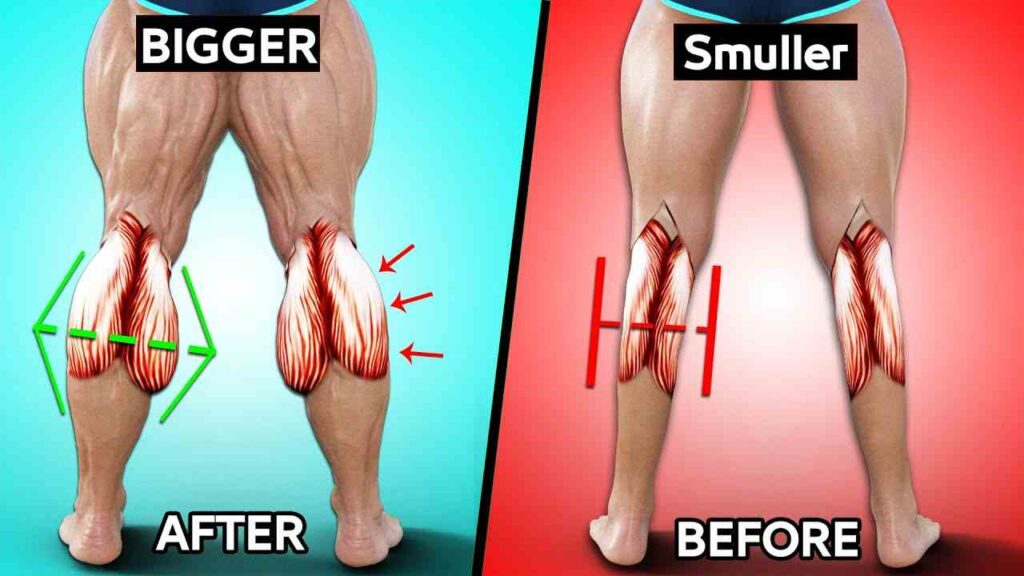Are you looking to strengthen and tone your legs? Cable machines can be a great addition to your workout routine! These machines use cables and weights to help you perform various exercises that target different leg muscles. Whether you’re a beginner or an experienced gym-goer, cable machine workouts can offer a safe and effective way to build muscle and improve your fitness. In this article, we’ll explore the benefits of using cable machines for leg workouts, introduce some basic and advanced exercises, and provide tips for creating a workout routine that suits your needs.
13 Cable Machine Workouts for Legs
Cable machines are incredibly versatile tools in the gym, offering a range of leg exercises that can help you build strength, size, and endurance. Here’s a comprehensive guide to cable machine workouts for legs:
1. Cable Squats
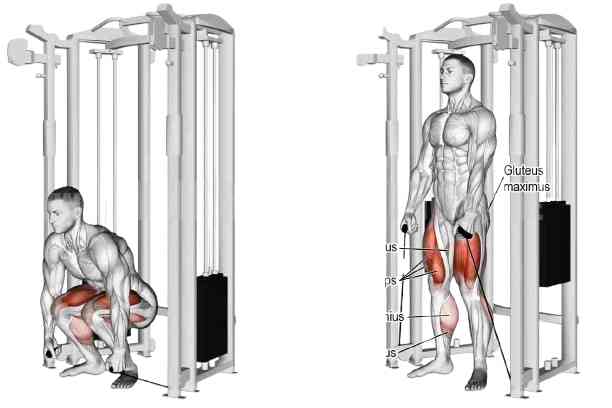
Cable squats engage your quads, hamstrings, and glutes, adding constant resistance throughout the movement.
How to Perform:
- Attach a straight bar to the low pulley on the cable machine.
- Stand facing the machine with feet shoulder-width apart, gripping the bar.
- Squat down, keeping your back straight and chest up, then push through your heels to return to the starting position.
Mistakes to Avoid:
- Don’t let your knees cave inward—keep them aligned with your toes.
- Avoid rounding your back, which can lead to injury.
2. Cable Kickbacks
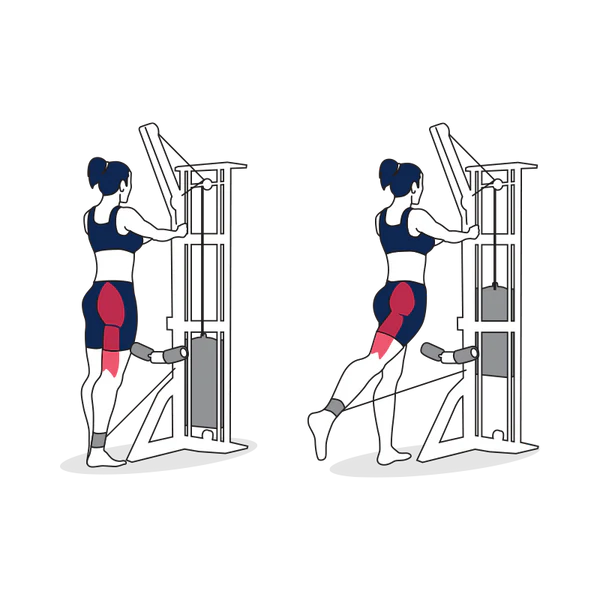
This exercise targets the glutes, helping to build strength and muscle tone in the posterior chain.
How to Perform:
- Attach an ankle strap to the low pulley, securing it around your ankle.
- Stand facing the machine, slightly bent forward, and kick your leg backward until you feel your glutes engage.
- Slowly return to the starting position and repeat.
Mistakes to Avoid:
- Avoid arching your back to lift the leg higher; keep your core tight.
- Don’t swing the leg—use controlled movements to activate the glutes.
3. Cable Lunges
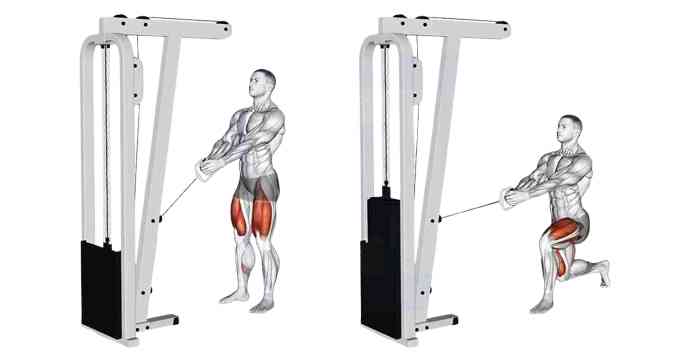
Cable lunges target the quads, glutes, and hamstrings while engaging core stabilizers for balance.
How to Perform:
- Attach a rope handle to the low pulley.
- Stand facing the machine, holding the rope with both hands, and take a step back into a lunge position.
- Lower your back knee toward the floor, keeping your front knee in line with your toes. Push through the front heel to stand back up.
Mistakes to Avoid:
- Don’t let your front knee extend past your toes—this puts stress on the joint.
- Avoid leaning forward—keep your torso upright.
4. Cable Pull-Throughs
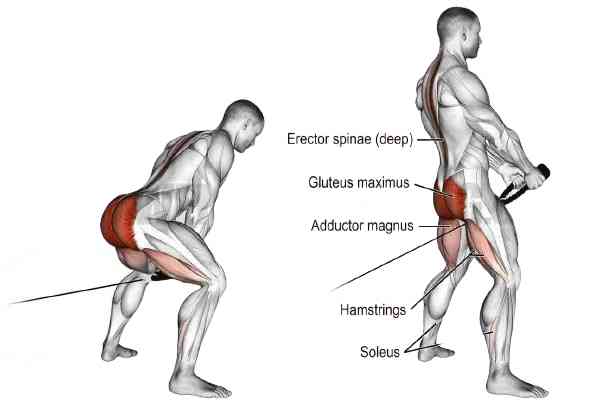
SHOP FOR THE CABLE MACHINE ON AMAZON
Great for working the hamstrings, glutes, and lower back, cable pull-throughs provide a solid hinge movement.
How to Perform:
- Attach a rope handle to the low pulley, and stand facing away from the machine with legs shoulder-width apart.
- Grab the rope between your legs, hinge at the hips, and pull the rope forward while standing up straight. Squeeze your glutes at the top.
Mistakes to Avoid:
- Avoid turning it into a squat—keep the focus on hinging at the hips.
- Don’t round your lower back—maintain a neutral spine throughout.
5. Cable Leg Curls
This isolation exercise targets your hamstrings, helping to improve leg stability and strength.
How to Perform:
- Attach an ankle strap to the low pulley, secure it around your ankle, and stand facing the machine.
- Curl your leg upward by bending your knee, pulling the cable behind you. Slowly lower it back down.
Mistakes to Avoid:
- Don’t use momentum—keep the movement slow and controlled.
- Avoid arching your back; focus on using your hamstrings.
6. Cable Step-Ups
Cable step-ups build strength in the quads, hamstrings, and glutes, improving balance and stability.
How to Perform:
- Attach a straight bar or handle to the low pulley.
- Place a bench or step in front of the cable machine and hold the bar with both hands.
- Step one foot onto the bench, driving through your heel to lift your body. Step down with control and repeat.
Mistakes to Avoid:
- Don’t let your knee extend past your toes.
- Avoid using momentum—focus on controlled movement.
7. Cable Romanian Deadlifts (RDLs)
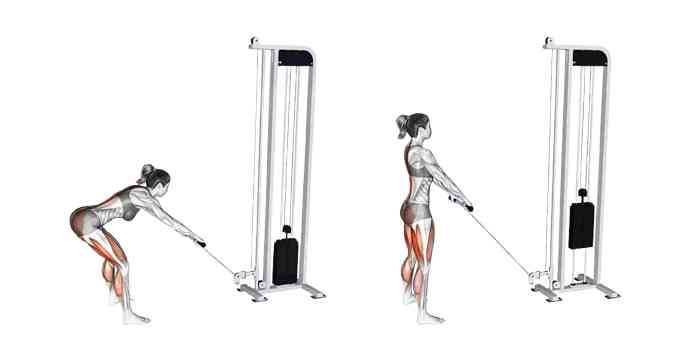
This exercise strengthens the hamstrings, glutes, and lower back by focusing on the hip hinge movement.
How to Perform:
- Attach a straight bar to the low pulley.
- Stand facing the machine with feet shoulder-width apart, holding the bar with both hands.
- Hinge at your hips, lowering the bar to mid-shin level while keeping your back flat. Return to the standing position by engaging your glutes.
Mistakes to Avoid:
- Don’t round your lower back—keep your spine neutral.
- Avoid bending your knees too much; this is not a squat.
8. Cable Side Lunges
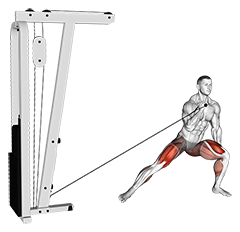
Cable side lunges target the inner and outer thighs, glutes, and quads, enhancing hip mobility.
How to Perform:
- Attach a D-handle to the low pulley.
- Stand with your side facing the machine, holding the handle in one hand.
- Step laterally into a lunge position, bending one knee while keeping the other leg straight. Push back to the starting position.
Mistakes to Avoid:
- Don’t let your knee go past your toes.
- Avoid leaning forward—keep your chest up.
9. Cable Hip Abductions
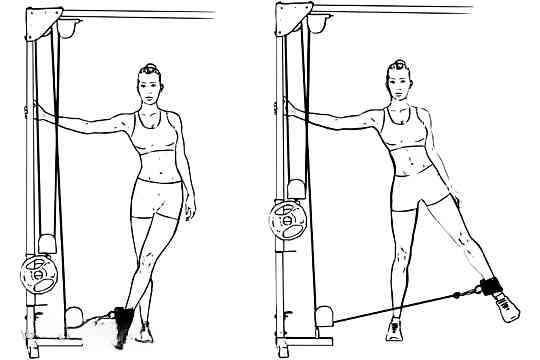
This exercise focuses on the outer thighs and glutes, improving hip stability.
How to Perform:
- Attach an ankle strap to the low pulley and secure it to your outside ankle.
- Stand sideways to the machine and lift your leg out to the side, keeping it straight. Slowly return to the starting position.
Mistakes to Avoid:
- Don’t swing your leg—keep the movement controlled.
- Avoid leaning too much to the opposite side.
10. Cable Glute Bridge
SHOP FOR THE RESISTANCE BAND ON AMAZON
This exercise isolates the glutes, providing great muscle activation for building strength and shape.
How to Perform:
- Attach the rope to the low pulley and lie on your back with knees bent, feet flat.
- Hold the rope between your legs and push through your heels to lift your hips until your body forms a straight line. Lower slowly.
Mistakes to Avoid:
- Don’t overextend your lower back—engage your core to prevent arching.
- Avoid pushing through your toes—drive through your heels.
11. Cable Front Squats
Cable front squats target the quads and core, providing resistance at the front of your body for improved posture.
How to Perform:
- Attach a straight bar to the low pulley.
- Stand facing the machine with feet shoulder-width apart and hold the bar at shoulder height.
- Squat down by bending your knees, keeping your chest up and back straight. Return to the starting position.
Mistakes to Avoid:
- Don’t let your knees cave inwards—keep them aligned with your toes.
- Avoid rounding your upper back—maintain a tall posture.
12. Cable Hamstring Curls
This isolation move works the hamstrings, adding constant tension for better muscle activation.
How to Perform:
- Attach an ankle strap to the low pulley and lie face down on a bench or mat.
- Curl your leg up toward your glutes, keeping your upper body still. Slowly lower your leg back down.
Mistakes to Avoid:
- Don’t lift your hips off the bench—keep them stable.
- Avoid using momentum—control the movement throughout.
13. Cable Standing Calf Raises
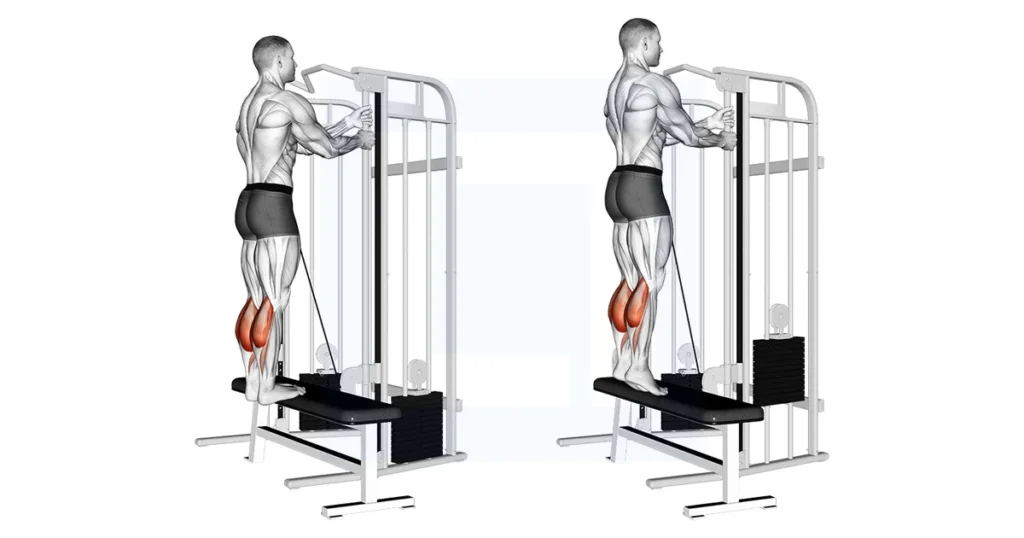
Cable calf raises to build strength and definition in the calf muscles.
How to Perform:
- Attach a straight bar to the low pulley.
- Stand facing the machine with feet shoulder-width apart, holding the bar.
- Lift your heels off the floor, rising onto the balls of your feet, and slowly lower them back down.
Mistakes to Avoid:
- Don’t bounce—use a controlled motion.
- Avoid rolling your ankles—keep them stable.
Romanian Deadlift and Lower Back
By incorporating these cable machine workouts for legs into your routine, you can effectively target all major leg muscles and achieve a well-rounded lower-body workout.
Progressive Overload With Cable Machines
Progressive overload is a key principle in strength training, aimed at continually challenging your muscles to stimulate growth and increase strength. When using cable machines for leg workouts, applying this principle effectively involves gradually increasing the demands on your muscles. Here’s how you can incorporate progressive overload with cable machines:
SHOP FOR THE PROTEIN POWDER ON AMAZON
1. Increase Resistance
- Adjust Weights: Start by gradually increasing the weight on the cable machine. Small increments (2.5-5 lbs) can make a significant difference over time.
- Use Multiple Weight Plates: If your machine allows, add more weight plates to increase resistance.
2. Change the Cable Position
- Adjust the Pulley Height: Moving the pulley to different heights can alter the angle of resistance and target different parts of the muscle.
- Change the Pulley Angle: Using low, mid, or high pulley settings can provide a different resistance curve and challenge the muscles in new ways.
3. Increase Repetitions or Sets
- Higher Reps: Gradually increase the number of repetitions per set. For hypertrophy (muscle growth), aim for 8-12 reps per set.
- More Sets: Increase the total number of sets for each exercise. This can enhance muscular endurance and strength.
4. Shorten Rest Periods
- Reduce Rest Intervals: As you progress, shorten the rest periods between sets to keep your muscles under tension for longer and improve cardiovascular conditioning.
5. Incorporate Advanced Techniques
- Drop Sets: Perform a set to failure, then reduce the weight and continue for more reps. This intensifies the workout and pushes muscles beyond their normal capacity.
- Supersets: Pair two exercises back-to-back with no rest in between to increase workout intensity.
- Time Under Tension: Slow down the movement to increase the time your muscles are under tension. This can enhance muscle engagement and growth.
6. Focus on Form and Range of Motion
- Perfect Your Form: Ensure your form is correct to maximize muscle activation and prevent injury. Better form often leads to more effective overload.
- Full Range of Motion: Make sure you are using the full range of motion for each exercise to fully engage the muscle.
7. Track Your Progress
- Log Your Workouts: Keep a workout journal or use an app to track weights, sets, reps, and any other metrics. This helps you see progress and make informed adjustments.
8. Variation and Adaptation
- Change Exercises: Regularly vary your exercises to target muscles from different angles and prevent adaptation. This helps in continuously challenging your muscles.
- Incorporate Unilateral Training: Using one leg at a time for certain exercises can help correct muscle imbalances and further stimulate muscle growth.
SHOP FOR THE FITNESS TRACKER ON AMAZON
By systematically applying these strategies, you can ensure that your leg workouts on the cable machine remain challenging and effective, leading to improved strength and muscle growth over time.
Benefits of Cable Machine Workouts for Legs
When it comes to leg workouts, cable machines offer several unique advantages. Here are the key benefits:

1. Constant Tension on Muscles: Unlike free weights, where tension can vary depending on your position, cable machines provide continuous resistance throughout the movement. This means your muscles are engaged the entire time, which can lead to more effective muscle growth and endurance.
2. Versatile Range of Motion: Cable machines allow for a greater range of motion and different angles for exercises, making it easy to target specific leg muscles from various directions. This is particularly helpful for isolating muscles like the glutes or inner thighs, which can be harder to hit with traditional exercises.
Benefits of Hanging Leg Raises
3. Better Muscle Activation: The adjustable nature of the cable machine forces your muscles to stabilize and control the weight, engaging multiple muscle groups at once. This is especially beneficial for improving core stability and overall balance while doing leg exercises.
4. Low Impact on Joints: Cable machines provide a more controlled environment compared to free weights, which can reduce the risk of injury or joint strain. The smooth motion of the cables helps protect your knees, hips, and lower back, making it ideal for people recovering from injury or those with joint issues.
5. Variety of Exercises: With the cable machine, you can perform a wide variety of leg exercises from squats and lunges to kickbacks and leg curls. The versatility helps in targeting all the major leg muscles (quads, hamstrings, glutes, and calves) with just one piece of equipment.
6. Improved Control and Form: Cable machines often come with adjustable settings that allow you to control the intensity and range of your workout. This can help you focus on proper form, reducing the likelihood of injury and ensuring you’re engaging the right muscles.
7. Progressive Overload Made Easy: You can easily adjust the weight on a cable machine, which makes it simple to apply progressive overload—the key to muscle growth. This flexibility allows you to increase resistance gradually, helping you build strength over time.
8. Suitable for All Fitness Levels: Whether you’re a beginner or a seasoned athlete, cable machines offer exercises that can be scaled to your fitness level. Beginners can start with lower resistance to focus on form, while advanced users can challenge themselves with heavier weights and complex movement patterns.
Best Leg Exercise: Hack Squat or Leg Press?
Incorporating these benefits into your leg workouts can help improve muscle tone, strength, and overall leg conditioning, making the cable machine an invaluable tool for leg day.
Leg Workouts for Different Goals
When it comes to leg workouts, different goals require different approaches. Here’s how to tailor your leg workouts for various objectives:

1. Strength Building
Goal: Increase overall strength and power in the legs.
Workout Focus: Heavy weights and low reps.
Sample Exercises:
- Cable Squats: 3-5 sets of 4-6 reps with heavy resistance.
- Cable Romanian Deadlifts: 3-5 sets of 4-6 reps.
- Cable Lunges: 3-4 sets of 6-8 reps per leg.
Tips:
- Use high resistance and focus on proper form.
- Allow longer rest periods (2-3 minutes) between sets to recover fully.
- Incorporate compound movements that engage multiple muscle groups.
2. Muscle Hypertrophy (Muscle Growth)
Goal: Increase muscle size and definition.
Workout Focus: Moderate weights and moderate reps with shorter rest periods.
Sample Exercises:
- Cable Kickbacks: 3-4 sets of 10-12 reps.
- Cable Leg Extensions: 3-4 sets of 10-12 reps.
- Cable Glute Bridges: 3-4 sets of 10-12 reps.
Tips:
- Use moderate resistance to achieve muscle fatigue.
- Focus on controlled movements and muscle contraction.
- Keep rest periods between 60-90 seconds to maximize muscle pump.
3. Endurance
Goal: Improve muscular endurance and stamina.
Workout Focus: Light weights and high reps with minimal rest.
Sample Exercises:
- Cable Step-Ups: 3-4 sets of 15-20 reps per leg.
- Cable Side Lunges: 3-4 sets of 15-20 reps per leg.
- Cable Standing Calf Raises: 3-4 sets of 20-25 reps.
Tips:
- Use lighter resistance to allow for higher rep ranges.
- Shorten rest periods between sets to build endurance.
- Incorporate circuit training to keep your heart rate up.
4. Power Development
Goal: Enhance explosive power and speed.
Workout Focus: Explosive movements with moderate to heavy weights.
Sample Exercises:
- Cable Jump Squats: 3-4 sets of 8-10 reps.
- Cable Single-Leg Deadlifts: 3-4 sets of 8-10 reps per leg.
- Cable High Knees: 3-4 sets of 10-15 reps per leg.
Tips:
- Focus on explosive, high-intensity movements.
- Allow full recovery between sets to maintain power output.
- Incorporate plyometric exercises to complement your power training.
5. Flexibility and Mobility
Goal: Improve range of motion and flexibility in the legs.
Workout Focus: Stretching and mobility exercises.
Sample Exercises:
- Cable Leg Swings: 3-4 sets of 15-20 reps per leg.
- Cable Hip Abductions: 3-4 sets of 15-20 reps per leg.
- Cable Hamstring Curls: 3-4 sets of 15-20 reps.
Tips:
- Focus on slow, controlled movements to improve flexibility.
- Incorporate static stretching and dynamic stretches.
- Use light resistance and emphasize the full range of motion.
6. Rehabilitation and Injury Prevention
Goal: Strengthen the legs to prevent injuries and aid in recovery.
Workout Focus: Low weights, high reps, and proper technique.
Sample Exercises:
- Cable Glute Bridges: 3-4 sets of 12-15 reps.
- Cable Standing Calf Raises: 3-4 sets of 12-15 reps.
- Cable Side Leg Raises: 3-4 sets of 12-15 reps per leg.
Tips:
- Use light resistance to ensure safety.
- Focus on correct form and alignment.
- Include exercises that promote stability and balance.
SHOP FOR THE FOAM ROLLER ON AMAZON
By customizing your leg workouts to align with your specific goals, you can effectively target the desired outcomes while ensuring a well-rounded approach to leg training.
Anatomy of the Leg Muscles
Understanding the anatomy of the leg muscles can help you target them more effectively during your workouts. Here’s a breakdown of the major leg muscles:
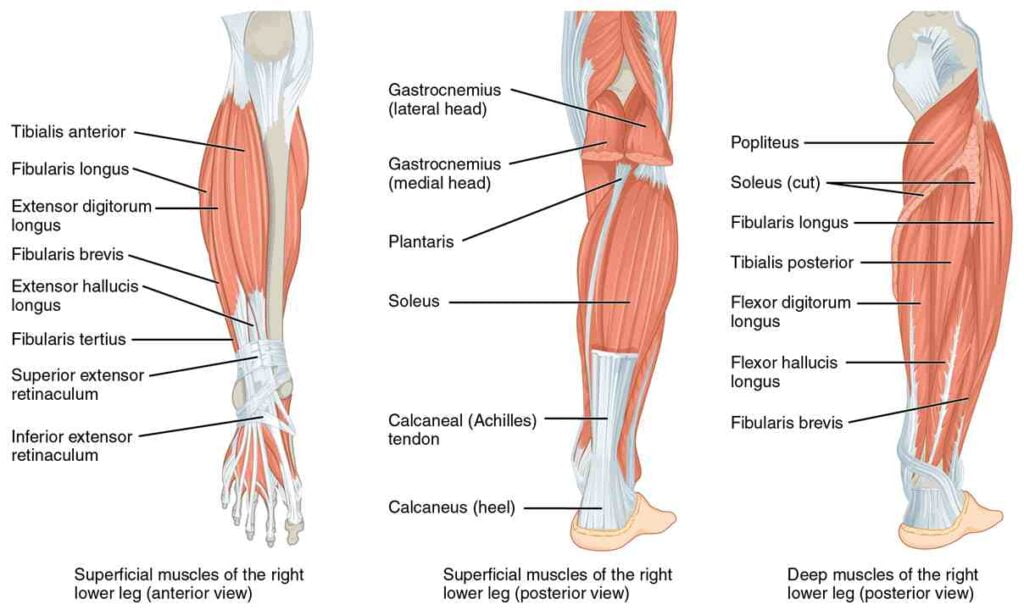
1. Quadriceps
The quadriceps, or “quads,” are a group of four muscles located at the front of the thigh. They are responsible for extending the knee and are crucial for movements like squats and lunges. The four muscles are:
- Vastus Lateralis: Located on the outer side of the thigh.
- Vastus Medialis: Found on the inner part of the thigh.
- Vastus Intermedius: Situated between the vastus lateralis and vastus medialis.
- Rectus Femoris: Runs down the middle of the thigh and also helps in hip flexion.
2. Hamstrings
The hamstrings are a group of three muscles located at the back of the thigh. They are responsible for bending the knee and extending the hip. The three muscles are:
- Biceps Femoris: The most lateral muscle of the hamstrings.
- Semimembranosus: Located on the inner side of the thigh.
- Semitendinosus: Positioned between the biceps femoris and semimembranosus.
3. Glutes
The gluteal muscles, or “glutes,” are located in the buttocks and are essential for hip extension, rotation, and stabilization. The three muscles are:
- Gluteus Maximus: The largest and most superficial glute muscle.
- Gluteus Medius: Located on the outer surface of the pelvis.
- Gluteus Minimus: The smallest and deepest of the glute muscles.
4. Calves
The calf muscles are located at the back of the lower leg and are responsible for movements like walking, running, and jumping. The main muscles are:
- Gastrocnemius: The larger, more prominent calf muscle.
- Soleus: Located underneath the gastrocnemius.
- Plantaris: A small muscle that is not present in everyone.
5. Adductors
The adductors are a group of muscles located on the inner thigh. They are responsible for bringing the legs together. The main muscles are:
6. Hip Flexors
The hip flexors are a group of muscles that help lift the thigh towards the body. The main muscles are:
- Iliopsoas: A combination of the iliacus and psoas major muscles.
- Sartorius: The longest muscle in the body, running from the hip to the knee.
Daily Calf Raises: Pros and Cons
Understanding these muscles can help you perform cable machine workouts more effectively and target specific areas for better results.
FAQs
Q 1. Can beginners use cable machines for leg workouts?
Ans. Yes, cable machines are suitable for all fitness levels, including beginners. Start with lighter weights and focus on proper form.
Q 2. How often should I do cable machine leg workouts?
Ans. Aim for 2-3 times a week, allowing at least one day of rest between sessions to let your muscles recover.
Q 3. Can cable machine workouts replace free weight exercises?
Ans. Cable machine workouts can complement free weight exercises, but it’s beneficial to include both in your routine for a balanced workout.
Q 4. What should I wear for cable machine workouts?
Ans. Wear comfortable, breathable clothing and supportive shoes. Avoid loose clothing that could get caught in the machine.
Q 5. How do I know if I’m using the correct weight?
Ans. Start with a weight that allows you to perform the exercise with proper form. If you can complete your reps without struggling, you can gradually increase the weight.
Q 6. What are the benefits of using cable machines over other gym equipment?
Ans. Cable machines offer constant tension, a wide range of motion, and the ability to target specific muscles more precisely.
Q 7. Can cable machine workouts help with injury rehabilitation?
Ans. Yes, cable machines can be used for rehabilitation under the guidance of a physical therapist or fitness professional.
Q 8. How can I track my progress with cable machine workouts?
Ans. Keep a workout journal to record the exercises, weights, and reps you perform. Regularly assess your strength and adjust your routine as needed.
Conclusion
Cable machine workouts are a fantastic way to strengthen and tone your leg muscles. They offer a variety of exercises that can target different parts of your legs, from your quads and hamstrings to your glutes and calves. Whether you’re just starting out or you’re an experienced gym-goer, cable machines can help you achieve your fitness goals safely and effectively. Remember to focus on proper form, start with a weight you can handle, and gradually increase the intensity as you get stronger. With dedication and consistency, you’ll be on your way to stronger, healthier legs in no time!

Good day, and welcome to Fitthour. My name is Shubham Vijay, and I am a certified personal trainer and nutrition coach with 6 years of experience in the fitness industry. At Fitthour, we specialize in types of training, such as strength training, cardio, or HIIT, and our mission is to help clients achieve their fitness goals and improve their overall health.

